Pomegranate Salmon
Glazed Pomegranate Salmon is an impressive and beautiful main dish that surprisingly takes just two steps and about 20 minutes to make. And the taste is out of this world!
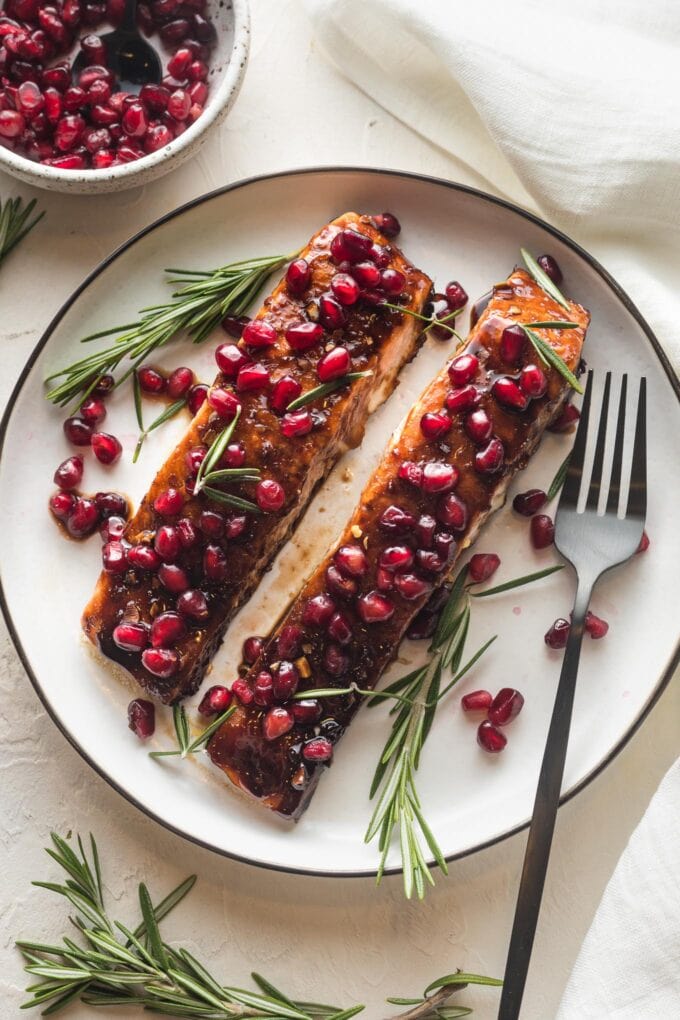
Everyone needs a few recipes that are sure to impress but secretly take minimal effort, and this pomegranate salmon is living right in that sweet spot.
It’s pretty, it’s elevated, it’s damn delicious. But it’s also incredibly easy to make.
I’m fine if you want to keep that last part our secret. 🙂
Use this simple pan-roasting technique to guarantee tender salmon and minimal mess. This method is easily adaptable whether you want to serve individual salmon filets or a single large side of salmon for a holiday, entertaining, or other occasion.
The result, in any case, is perfectly-cooked salmon coated in a luxurious pomegranate ginger sauce, dotted with fresh pomegranate arils for more color and crunch.
Ingredients & Common Substitutions
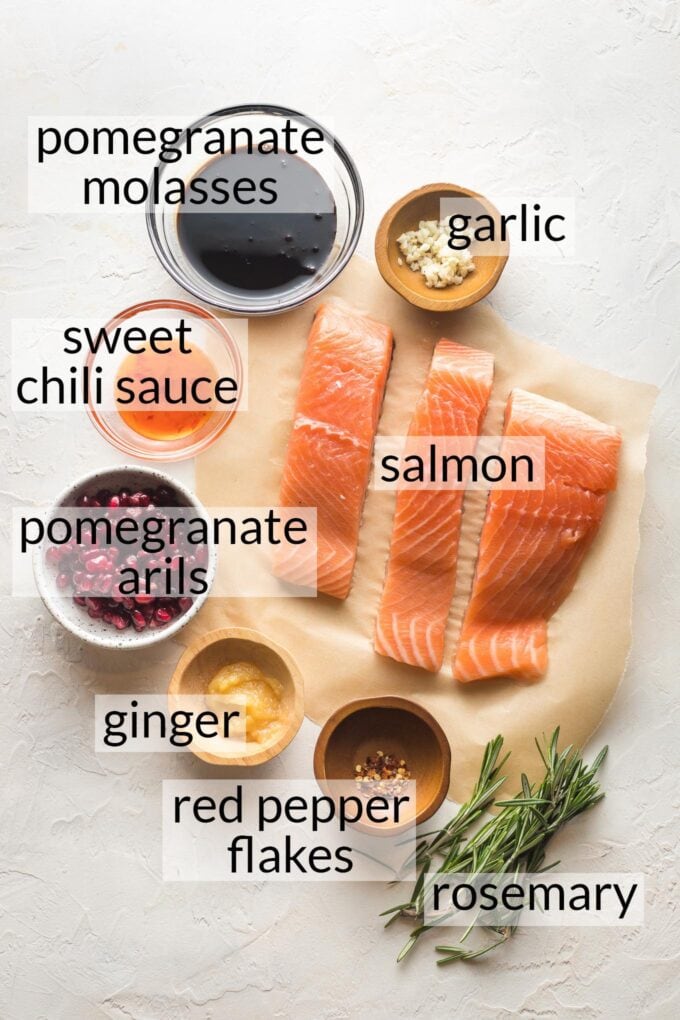
Here are a few notes and shopping tips about the ingredients you’ll need to make pomegranate salmon, as well as possible substitutions:
- Salmon. Use individual salmon filets, which are sometimes sold as “BBQ-cut,” for easy serving, or for a very impressive presentation, purchase one large side of salmon. The recipe works exactly the same either way. You can read about the differences between farm-raised and wild-caught salmon here.
- Pomegranate molasses. The key ingredient to the best tasting glaze!
- Sweet chili sauce. With a little heat and a little sugar, sweet chili sauce just adds a little extra pizzazz to this simple salmon glaze. If you don’t have it, leave it out, or try substituting a mix of 1 part Sriracha or another tomato-based hot sauce and 3 parts honey (really!).
- Fresh minced ginger. You can also use ginger paste or frozen cubes of crushed ginger. I do not recommend using ground ginger; I would just omit it entirely.
- Fresh minced garlic. Garlic paste or jarred minced garlic are good substitutes. Use 1/4 teaspoon garlic powder in a pinch.
- Red pepper flakes. Just a pinch for flavor.
- Pomegranate arils. AKA pomegranate seeds, these are a must for color, flavor, and texture. Buy a package of arils or whack them out of a pomegranate on your own — it’s easier than you think and kind of fun!
- Rosemary, for garnish. Basil or thyme are nice options, as well.
Sourcing Tip: We get all of our meat, including most of our seafood, in a bi-monthly box from ButcherBox, and absolutely love it. The quality, convenience, and value are amazing, and I love having confidence that everything we buy and eat is humanely raised. Full disclosure: I am a proud ButcherBox affiliate, because we still love the service after paying for it two years and running!
What is pomegranate molasses?
Pomegranate molasses is a thick, syrupy condiment closely associated with Middle Eastern cooking. It’s well worth buying a small bottle for this recipe, and if you have a bit extra, use it in a salad dressing or drizzle over oatmeal. (Or make this salmon again!)
Interested in making your own pomegranate molasses? Alton Brown has a good recipe, for which you’ll need only three items:
- Pomegranate juice
- Sugar
- Lemon juice
Let it reduce, and you’ll have a small jar of the most addictive syrup you can imagine. Sweet and tangy all at once.
Can I use pomegranate juice in place of pomegranate molasses?
No. Pomegranate juice, even if mixed with corn starch or another thickening agents, is too thin to coat and adhere to the salmon. Believe me, I’ve tried!
If pomegranate juice is all you have or can find, budget the extra time to use the juice to make pomegranate molasses, and you will be all set from there.
How To Make Pomegranate Salmon
Place salmon on a rimmed baking sheet lined with parchment paper. For best results, scrunch up the parchment a bit around the salmon to hold more of the glaze.
Stir together the glaze in a small bowl or liquid measuring cup, pour over the salmon, and brush lightly (or use a spoon) to evenly coat all of the salmon with the glaze.
Now you just have to roast the salmon! Pop the baking sheet into a 425 degree oven and begin checking the salmon for doneness after about 10 minutes. It usually takes mine closer to 15 minutes, and especially thick filets might take more than that, but of course it’s better to check sooner and more often than to wait too long.
What is the best way to tell when salmon is done?
There are several ways to tell when salmon is cooked through. Firstly, the color will change from translucent, raw red, to a more opaque pink. Another easy test is to press gently on the filet with a fork or your finger — cooked salmon will flake easily, meaning it separates along the white lines that criss-cross the filet. These lines are strips of fat.
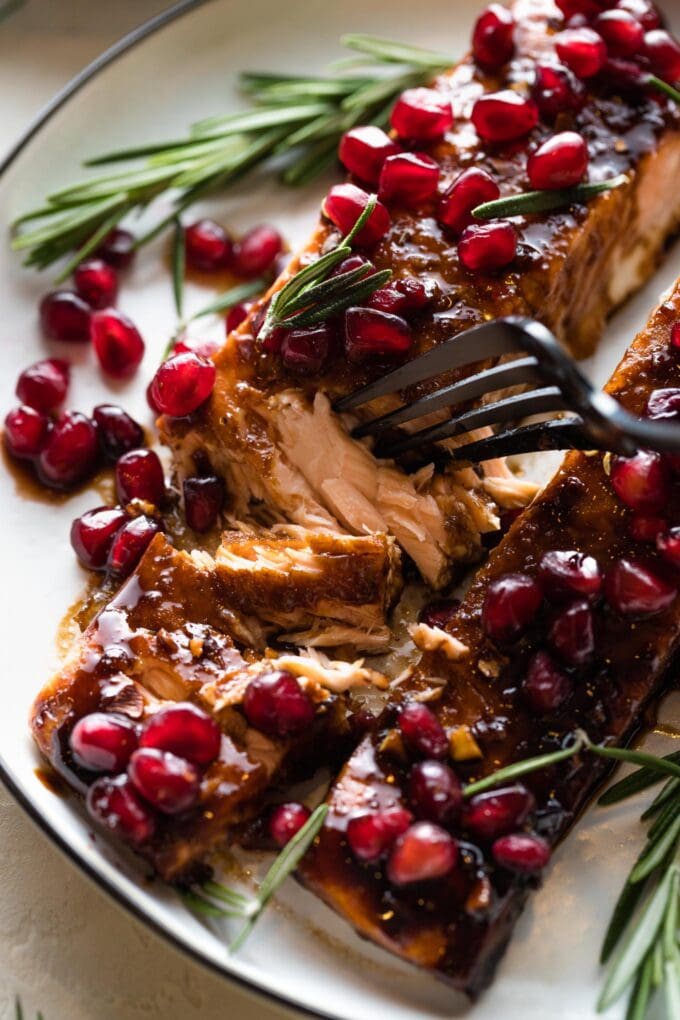
If you have an instant read thermometer, which I highly recommend, you can eliminate the guesswork by taking your salmon’s temperature! The FDA recommends cooking salmon to an internal temperature of 145°F. However, many chefs prefer to cook salmon to medium — between 125°F and 135°F — for a flakier, more tender result.
Can you overcook salmon?
It is definitely possible to overcook salmon, and the results are not good! Overcooked salmon is usually tough, dry, and chalky, and is responsible for many people believing they don’t like the fish at all. The one rule of thumb to making good salmon: watch carefully and do not overcook.
I will say that farm-raised salmon is more forgiving than wild-caught in the overcooking department. It tends to be fattier than wild-caught and therefore to stay more juicy, even on the off chance it gets a bit over done.
Help! My salmon is frozen solid! What do I do?
It’s important to keep salmon cold as it thaws, to prevent the growth of bacteria and potential illness. With that in mind, there are three ways to thaw frozen salmon:
- Recommended Same-Day Method: Fill a large bowl with cold water, place salmon in a zip-lock bag and close tightly, then submerge the bag in the cold water. Change the water or add ice periodically to keep the bowl cold until the salmon is tender. You may be tempted to do this with hot water, but try not to: it can compromise the texture of the fish, and risks warming the salmon more than is safe.
- Fastest Method: Use your microwave’s defrost setting. Place the salmon on a plate, cover with a paper towel, and use the automatic defrost function. Flip the salmon every 45-60 seconds to ensure it defrosts evenly, and remove the salmon as soon as it’s tender and can be bent, even if it still has a few ice crystals.
- Easiest Method: Place frozen salmon in the refrigerator overnight. Remove from tight packaging if possible, place on a rimmed plate, and cover with plastic wrap. It will be the perfect texture to cook with the following day.
Storage & Reheating
Extra pomegranate salmon? Lucky you!
- Store leftovers in the refrigerator, tightly covered, for up to 4 days.
- Reheating? Ask yourself if you really need to! Salmon can be finicky when reheated, often losing its tender, flaky texture. Cold salmon straight from the fridge is a delicious lunch, on its own, over rice, or topping a salad!
- If you must reheat, use the microwave in short intervals on 50% power.
Serving Suggestions
Serve pomegranate salmon with a generous sprinkling of fresh pomegranate arils and a garnish of fresh herbs–my favorite is rosemary, but basil or thyme are lovely, also.
Serve alongside couscous or rice, or on a bed of mashed cauliflower or sweet potatoes. Roasted vegetables make a phenomenal side–Brussels sprouts and carrots are two of our favorites.
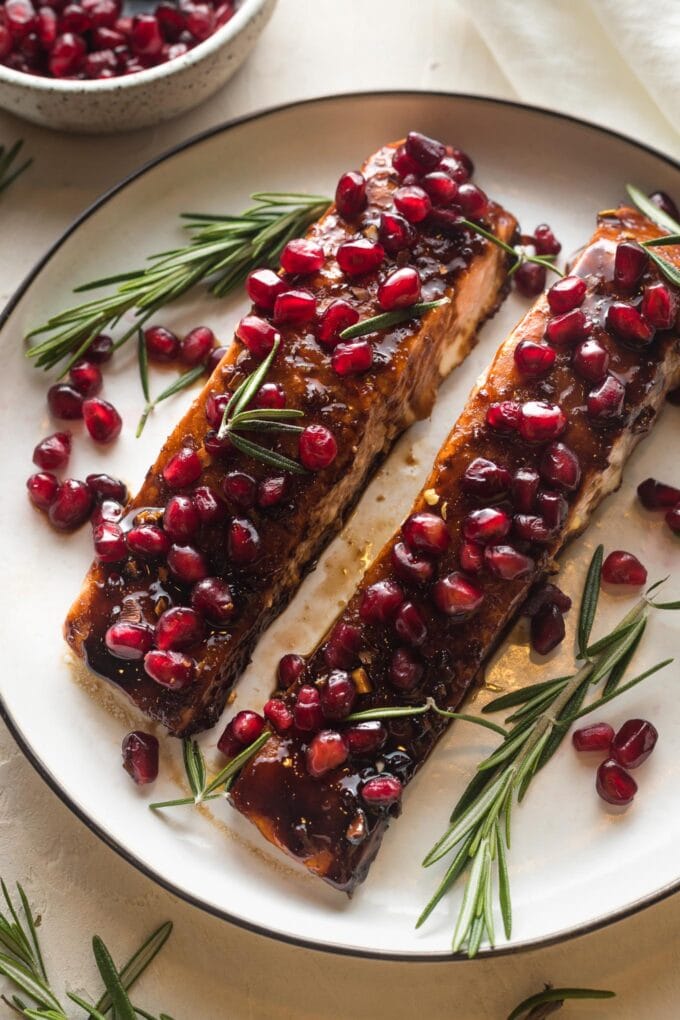
More Easy Salmon Recipes
- Pan-Seared Pistachio Herb Salmon
- Mustard-Crusted Baked Panko Salmon
- Parchment-Baked Lemon Salmon with Potatoes and Zucchini
- Rosemary Garlic Sheet Pan salmon
- Salmon Pesto Pasta
- Greek Salmon Salad
If you make this Pomegranate Salmon, don’t forget to rate the recipe and leave a comment below. I love hearing how recipes turn out in your kitchen, and it helps other readers, too.
You can also FOLLOW me on PINTEREST, INSTAGRAM, FACEBOOK, and TWITTER for more great recipes and ideas!
Pomegranate Salmon
Ingredients
- 1/4 cup pomegranate molasses
- 1 tablespoon sweet chili sauce
- 2 teaspoons fresh grated ginger
- 1 clove garlic minced
- pinch red pepper flakes
- 1 pound salmon
- pomegranate arils
- fresh rosemary, basil, or thyme
Instructions
- Preheat oven to 425 degrees F. Line a large rimmed baking sheet with parchment or foil.
- Combine pomegranate molasses, chili sauce, ginger, garlic, and red pepper flakes in a small liquid measuring cup. Stir the mixture into a syrupy sauce.
- Place salmon on the baking sheet, skin side down, and loosely scrunch up the parchment or foil around the salmon. Pour the pomegranate glaze on top of each piece, and brush gently into an even coat.
- Place pan in the oven and roast for 10-20 minutes, until the salmon is fully cooked. Fully cooked salmon will turn from a translucent, raw red to a more opaque pink color, and should flake easily into large pieces when pressed with a fork.
- Transfer salmon to a serving plate, garnish with fresh pomegranate arils and herbs, and serve.
Notes
- Watch the salmon carefully and test often after it has been roasting for 10 minutes. You do not want it to overcook! The FDA recommends cooking salmon to an internal temperature of 145 degrees F. Many cooks, however, feel comfortable and prefer serving it after it reaches 125-135 degrees F, resulting in a more tender piece of fish.
- If you want to try making your own pomegranate molasses, Alton Brown has a good recipe. It takes time to simmer but is very easy!
- Whether homemade or store-bought, you definitely want your pomegranate molasses to be at room temperature. If it’s cold it will be too thick to spoon easily over the salmon. If it’s still a little thick when you need it, a few seconds in the microwave works wonders.
Nutrition Estimate
This post was originally published December 22, 2018, and has been updated with a simpler recipe, more helpful text, and new photos.


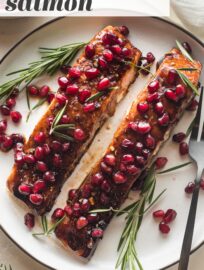
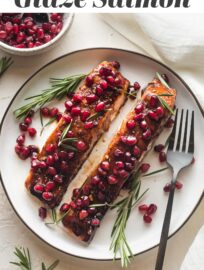
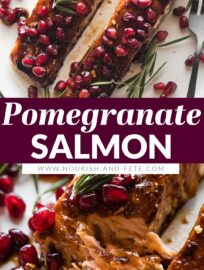
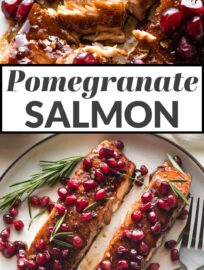
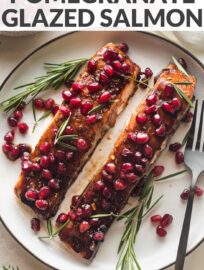

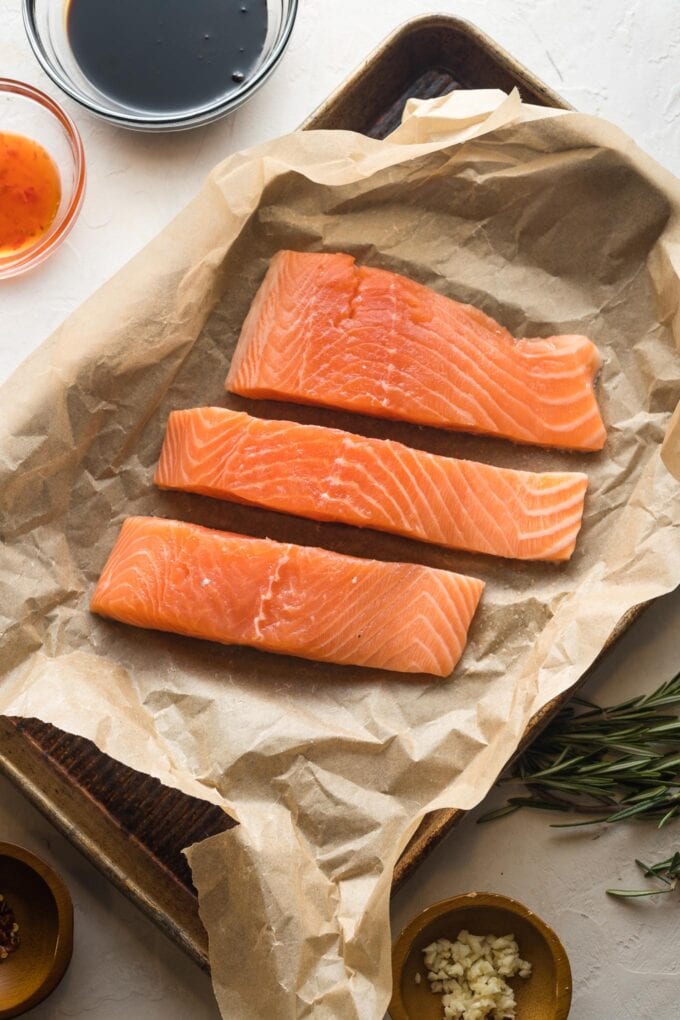
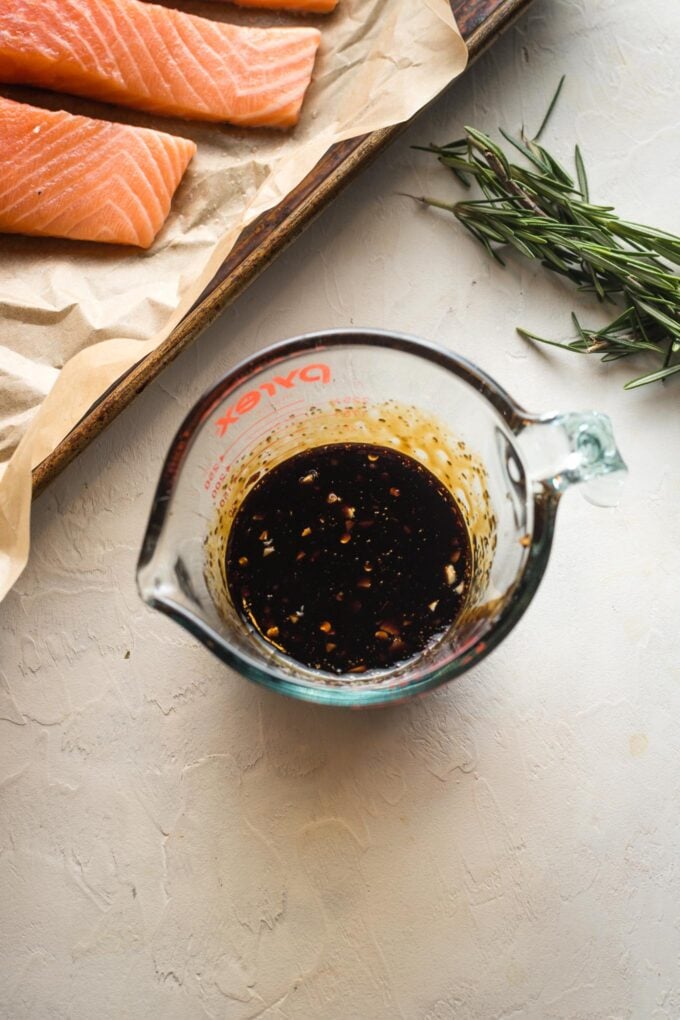
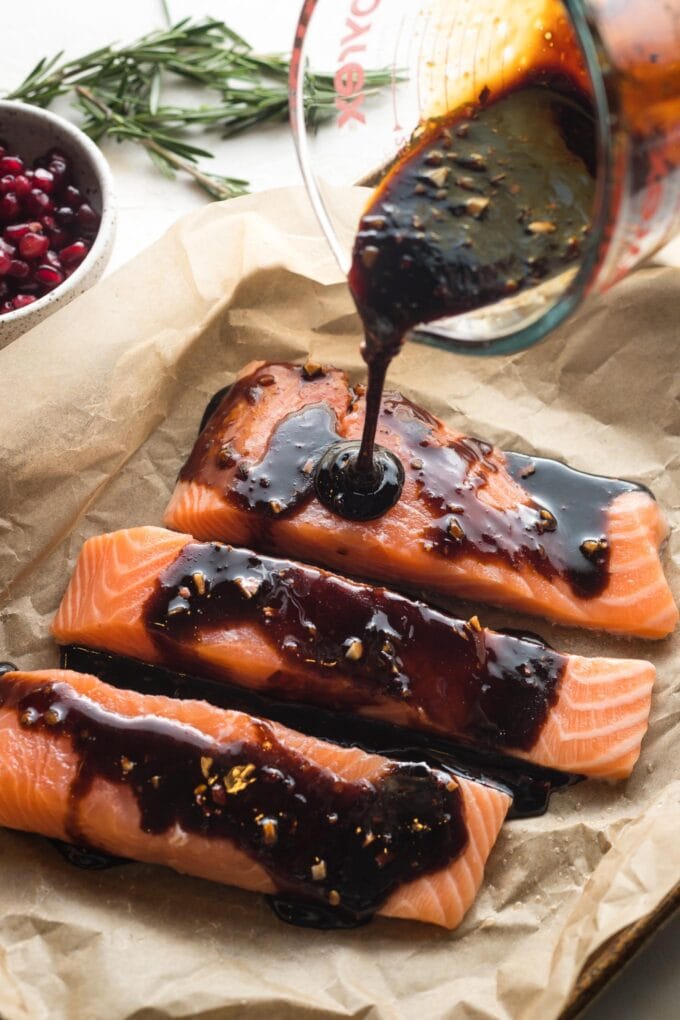
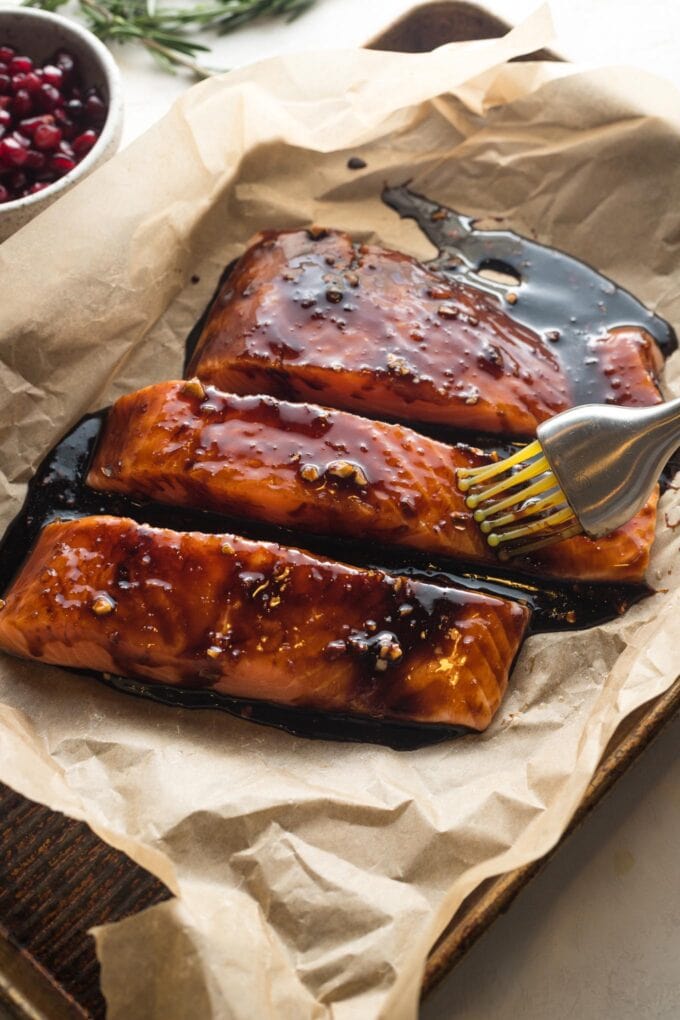
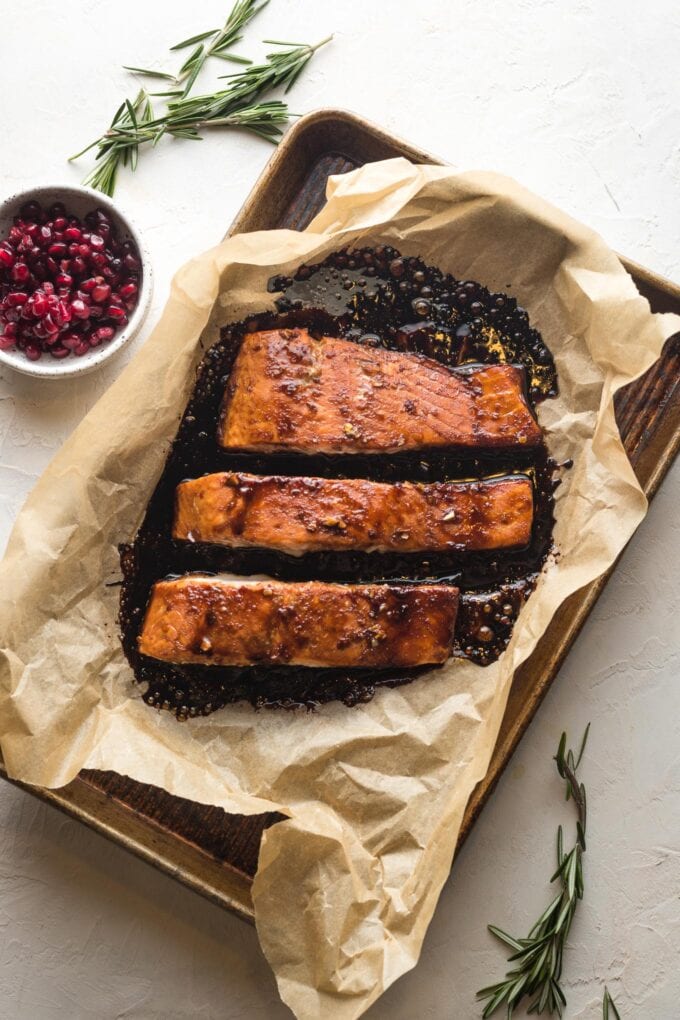
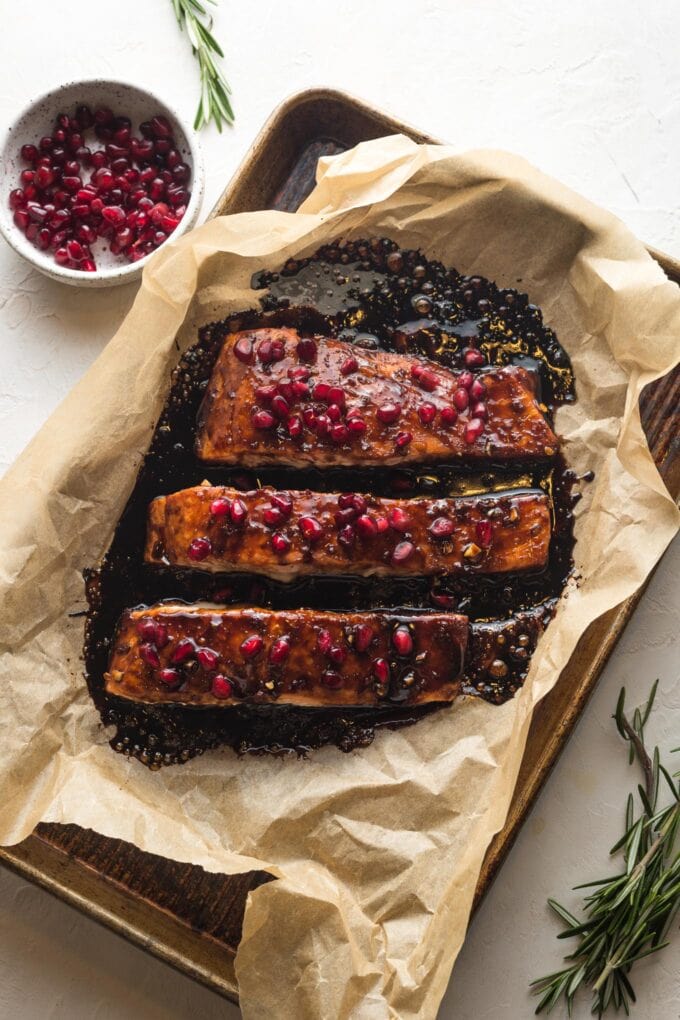


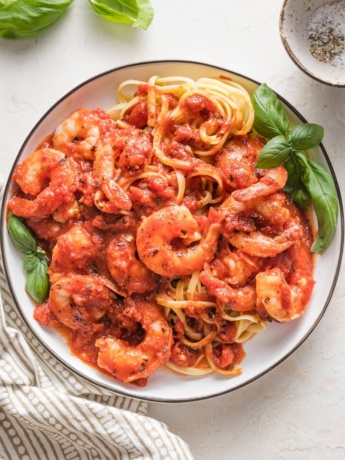
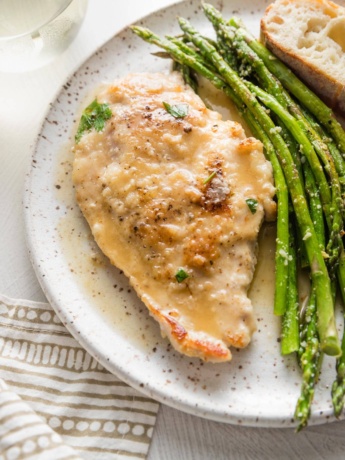
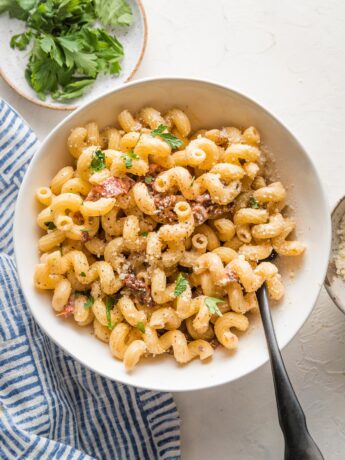
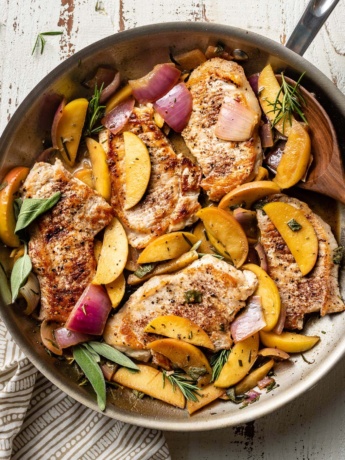
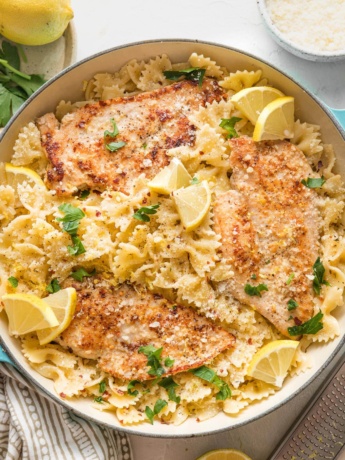
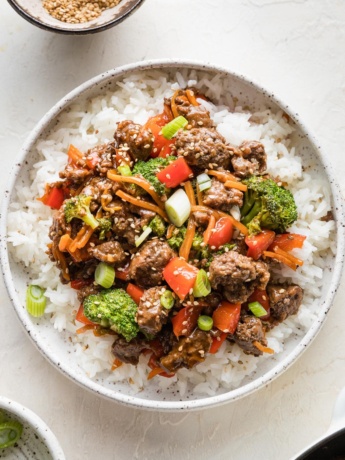
We loved this recipe! I used the exact ingredients listed, only I tripled the recipe and marinated the salmon.
I am going to try this recipe for Thanksgiving. I am not too familiar with salmon so when I ask for filets from the butcher, is there a certain weight they need to be?
I’m so happy to hear that – I hope you love it! There is no certain weight that you need for this recipe to work, though a good guideline is that a single salmon portion is usually about 4 ounces. Please let me know if you have any other questions as you cook – you can leave a comment, or for a quicker response, email me at [email protected] – and happy Thanksgiving!